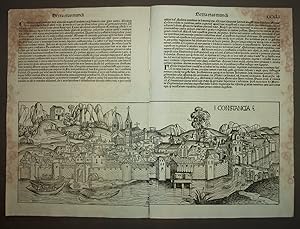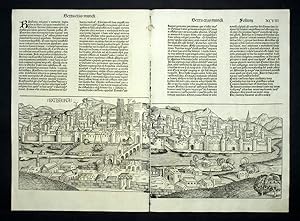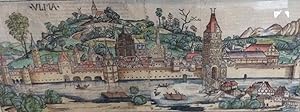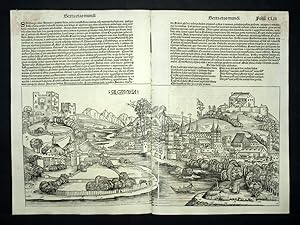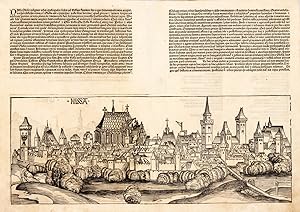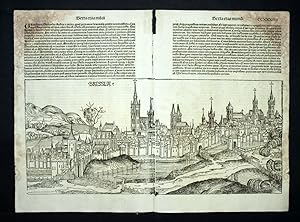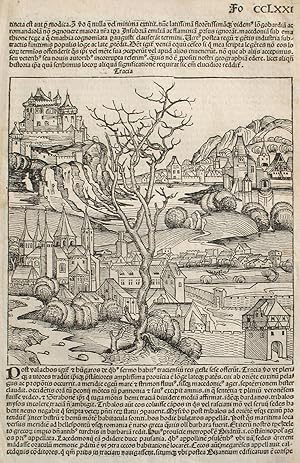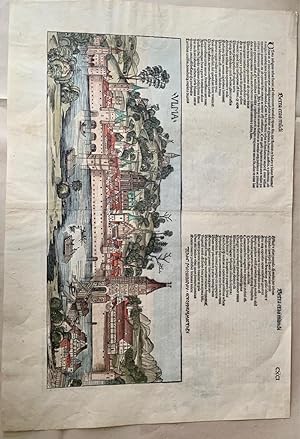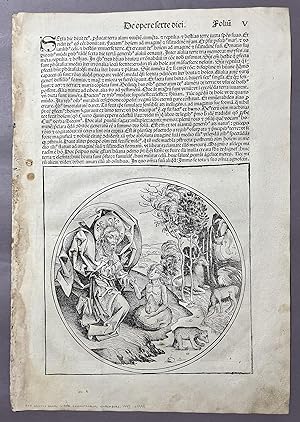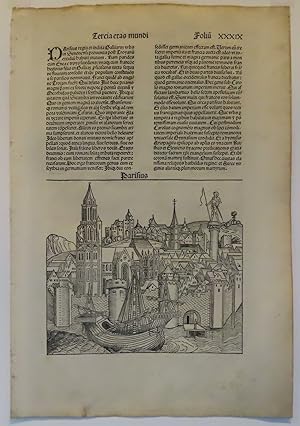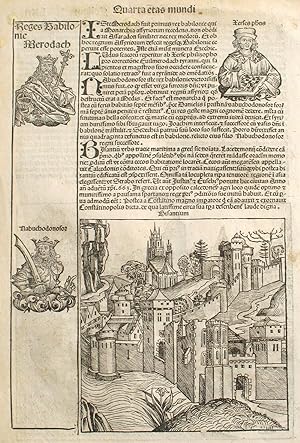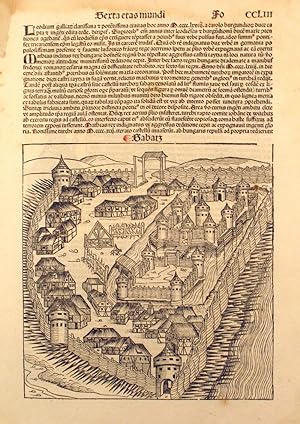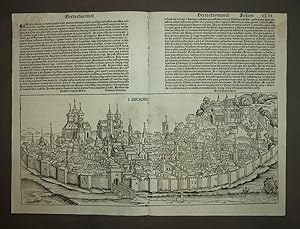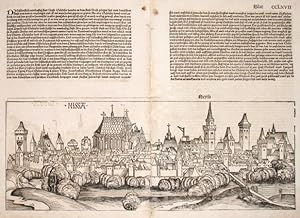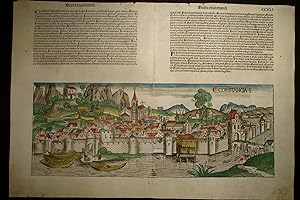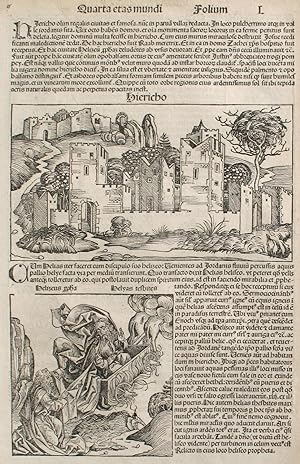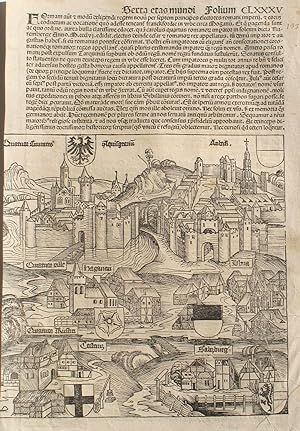Schedel, First Edition (101 results)
Product Type
- All Product Types
- Books (74)
- Magazines & Periodicals
- Comics
- Sheet Music
- Art, Prints & Posters (23)
- Photographs
- Maps (4)
-
Manuscripts &
Paper Collectibles
Condition
Binding
Collectible Attributes
- First Edition
- Signed (2)
- Dust Jacket (2)
- Seller-Supplied Images (82)
- Not Printed On Demand
Free Shipping
Seller Location
Seller Rating
-
[LIBER CHRONICARUM]. Registrum huius operis libri cronicarum cu[m] figuris et ymagibus ab initio mu[n]di.
Publication Date: 1493
Seller: Alexandre Antique Prints, Maps & Books, Toronto, ON, Canada
First Edition
Edition : First Edition in Latin., 17th century full calf over wooden boards, rebacked in style, spine with seven raised bands, gilt roulette on the boards with spandrels in the corners, blind-stamped fillets with gilt spandrels in the corners and central gilt design. Boards stamped in gilt with the name of a previous owner, Pierre de Hacqueville (Contemporary binding or slightly later)., Nuremberg, Antoine Koberger pour Sebald Schreyer and Sebastien Kamermaister, This chronicle represents the history of the world illustrated and divided into seven ages, from creation to 1490, the Last Judgement being the seventh age. Published in 1493 by Anton Koberger, one of the great printers of the time, the Nuremberg Chronicle is the work of the German humanist and physician from Nuremberg Hartmann Schedel (1440-1514), who drew his historical and geographical sources from his extensive library, one of the largest book collections of the 15th century. Among the designers and engravers of the woodcuts were the famous Michael Wolgemut (1434-1519), master of Albrecht Dürer, and his son-in-law Wilhelm Pleydenwurff (1460 ? -1494).The chronicle contains 1,800 figures from 645 different woodcuts, spread over most of the folios, some of them very large, with various motifs, including numerous biblical scenes, representations of cities or groups of monuments, figurative genealogical tables, etc. « One of the most extraordinary works ever produced » (The World encompassed)Provenance: illegible handwritten bookplate on title page. "Pierre de Hacqueville" (on the boards) Pierre de Hacqueville, King's Councillor, Corrector of the Chambre des Comptes, - Pierre de Hacqueville, Lord of Pomponne, Grand Master of the Waters & Forests of Brittany, late 16th-early 17th century ., Size : Folio (45 x 31 cm), The most lavishly illustrated incunabulum known as the "Nuremberg Chronicle"., (20) ff., I-CCLVIIII, CCLXII-CCLXVI, (5) ff.n.ch., CCLXVII-[CCC] 17th century calf, rebacked in style, Blank leaves CCLX and CCLXI missing. The 5 unnumbered leaves "De Sarmacia regione" are bound between ff. CCLXVI and CCLXVII but without the unnumbered blank leaf. Handwritten inscriptions in ink on the title - handwritten annotations to some ff., some ff. restored, some light spotting and staining, last map restored. Generally very good.
-
Liber chronicarum. [INCUNABULA]
Published by Nuremberg; Anton Koberger for Sebald Schreyer and Sebastian Kammermeister, 12 july 1493., 1493
First Edition
Encuadernación de tapa dura. Condition: Excelente. 1ª Edición. Fol. (43 x 29,5 cm). Plena piel de época sobre tabla, lomo restaurado, estuche de protección. 20 h. sin num. inc. port., CCIXC h., 2 h. bl., 5 h. sin num. incluyendo el suplemento De Sarmacia y h. bl. Capitulares a mano, en rojo y azul. Magníficamente ilustrado con 1809 grabados en madera, incluyendo mapas del mundo y de Europa, vistas de las principales ciudades europeas. Impresión en caracteres góticos de 64 líneas por plana. El Liber chronicarum, el mayor incunable ilustrado, con más de 1800 grabados en madera, constitye una gran historia universal compilada a partir de fuentes contemporáneas y otras anteriores a su época, por el doctor, humanista y bibliófilo de Nuremberg Hartmann Schedel (1440 1514), y supone uno de los libros más densamente ilustrados y técnicamente avanzados de los comienzos de la imprenta. Contiene 1809 grabados realizados a partir de 645 tacos xilográficos. Michael Wolgemut y Wilhelm Pleydenwurff ejecutaron las ilustraciones hacia 1490, momento en el que su taller estaba en pleno auge artístico y un joven Durero completaba allí su aprendizaje y de quien se cree participó en la elaboración de los grabados (cf. Wilson, The Making of the Nuremberg Chronicle, Amsterdam: 1976). Las vistas de los pueblos y ciudades, grabadas en madera, poseen gran interés artístico y topográfico. Incluye dos mapas a doble página, el mapa mundi basado en la Cosmographia de Pomponio Mela y un mapa de Europa por Münzer. Anotación manuscrita de época en portada, marginalia también de época en algunas páginas. HC *14508; BMC II, 437 (IC. 7451-3); Polain(B) 3469; CIBN S-161; BSB-Ink. S-195; Bod-Inc. S-108; Schreiber 5203; Goff S-307.
-
Liber chronicarum
Published by Anton Koberger for Sebald Schreyer and Sebastian Kammermeister, Nuremberg, 1493
Seller: Arader Books, New York, NY, U.S.A.
First Edition
Hardcover. Condition: Very good. First. THE NUREMBERG CHRONICLE. Nuremberg: Anton Koberger for Sebald Schreyer and Sebastian Kammermeister, 12 July 1493. First edition. Folio (16 5/8" x 11 13/16", 422mm x 300mm). [Full collation available.] Foll. CCLXIIII and CCLXVII supplied in facsimile; lacking the final blank (or two) after De Sarmacia. With some 1809 woodcuts, integral to the text, by Michael Wolgemut, Wihelm Pleydenwurff and almost certainly Albrecht Dürer. Bound in later dark mottled sheep (rebacked, with the original back-strip laid down), with a gilt fillet border. On the spine, six raised bands. Title (OPVS.CHRONIC./HANN.SCHEDEL.) gilt to red sheep in the second panel. Marbled end-papers. Rebacked, with the original back-strip laid down. First two panels of the backstrip split and coming up. Rubbed at the extremities. First free end-paper coming up. Initials (register-XV) and end-matter (CCXCI-end) mounted onto guards. Lacking leaves CCLXIIII and CCLXVII (supplied in facsimile) and the final blank (or two) after De Sarmacia. Leaf CLXXXVIII with loss to the lower spine-corner, supplied in facsimile. Various repairs (including one in thread to the 18th preliminary leaf). Leaf XCVIII slit horizontally. Leaf CCXCVI soiled at the fore-edge. Generally quite a clean copy, with good margins (albeit some shaved head-lines). Scattered marginalia (one (CXVIIIr) dated to 1555), mostly in secretarial hand. Armorial ex-libris of the convent of the Grands Augustins in Lyon and of Lionel H. Pries to the front paste-down. Pries's bibliographical cuttings pasted to the recto of the initial binder's blank. Obliterated bookplate adjacent to the Grands Augustins ex-libris. Armorial bookplate of a French count on the rear paste-down. Hartmann Schedel (1440-1514) is the historian who compiled the text of the Chronicae, but in some ways his was the least important role in the process of the book. In the era of printing's infancy (incunabula means "swaddling-clothes"), the printers and publishers (including investors) were often the more important agents in the creation of a book. Schedel lived on the same street as nearly all of his partners in the venture. This extraordinary neighborhood of book-producers came together to produce something that far surpassed the long-established genre of chronicles to which it belongs. Two colophons give different accounts of the work's completion; we know that it was begun in December of 1491. The first colophon (fol. CCLXVIr) gives 5 June 1493 as the date of completion. The second (fol. CCCv), which is fuller and gives the names of the publishers, gives 12 July 1493. The lasting appeal of the Chronicle, of which 1,205 copies survive according to the census in the Gesamtkatalog der Wiegendrucke, is its extraordinary woodcuts and their contribution to the overall layout. The cuts themselves vary widely in sophistication, from the almost modernist repeated cut of locusts to detailed city-views (for which the Chronicle is perhaps most famous) and the tight repertory of kings and queens, popes and popesses (Pope Joan on fol. CLXIXv is unmutilated; often zealous owners have scratched out her image or her description), which do not vary based on era or nationality. The volume must have resided for a time in Germany, as some of the marginal comments are in German, though most are in French. The unidentified armorial bookplate on the rear paste-down appears to be the oldest, and is likely French. The next point of ownership is the convent of the Grands Augustins in Lyon. Lionel "Spike" Pries (1897-1968) was a Seattle-based architect who studied at U.C. Berkeley and then at the University of Pennsylvania. Pries directed the Art Institute of Seattle (now the Seattle Art Museum) 1931-1932. BMC II, p. 437; BSB-Ink S-195; Gesamtkatalog der Wiegendrucke M40784; Hain (rev. Copinger), Repertorium bibliographicum II.2 *14508; Klebs, Incunabula scientifica et medica 889.1; ISTC no. is00307000; Sabin 77523; Shirley 19.
-
Das Buch der Croniken unnd geschichten mit figuren und pildnussen von Anbeginn der welt biss auff diese unsere Zeyt
Published by Johann Schönsperger, 1496
Book First Edition
Hardcover. Condition: Fine. 1st Edition. Augsburg, Johann Schönsperger, 1496. Contemporary blind-tooled pigskin over wooden boards, remains of metal clasps, folio (305 x 208mm). 332 ff, 51-52 lines and headline, Gothic type, 2 xylographic titles. With folded map and c. 1900 woodcuts, including a half-page world map, city views and portraits, woodcut Lombard capitals. Later first blank, lacking last blank, some worming to the 20 first and last pages, some small edge tears, two bottom corners (6 x 11 cm and 13 x 6 cm) and one top corner (4 x 3 cm) chipped. Complete. Hain 14511; Goff, S310 Good copy of Schönsperger s scarce small-format first edition of the Nuremberg Chronicle. RARE.
-
A SINGLE HAND-COLOURED BIFOLIUM FROM THE FAMED NUREMBERG CHRONICLE, showing the full view of ROME, Leaves LVII and LVIII
Published by [Nuremberg Anton Koberger, for Sebald Screyer and Sebastian Kammermeister 1493], 1493
Seller: Buddenbrooks, Inc., Newburyport, MA, U.S.A.
First Edition
First Edition with the German text. The bi-folium with fine hand-colouring to the Rome view. This is one of the large, double-page city-view woodcuts from the workshop of Mighael Wolgemut and Wilhelm Pleydenwurff beneath 22 lines of text. It is handsomely and finely handcoloured in blues, greens, yellows, reds, grays, etc. Double-page folio ( ca. 540 x 380 mm ), handsomely mounted, framed and glazed. Leaves LVII and LVIII. In fine condition and very well preserved and presented. FROM THE FIRST EDITION OF THE NUREMBERG CHRONICLE, ARGUABLY THE GREATEST ILLUSTRATED BOOK OF THE 15TH CENTURY. The artists, Michael Wolgemut, the well-known teacher of Albrecht Dürer, and his stepson, Wilhelm Pleydenwurff have been praised and admired for over five-hundred years for their contributions to one of the monuments of early printing. David Bland calls it "a marvelous book, and a landmark in the history of illustration," and through the ages it has more than fulfilled Koberger's prophecy that it would be "the delight of the men of learning and of everyone who had any education at all." A HIGHLY IMPORTANT INCUNABLE, the "Nuremberg Chronicle" is the most extensively illustrated book of the fifteenth century, and after the Gutenberg Bible the most celebrated book printed in the fifteenth century. Its 1,809 woodcut illustrations (1,164 excluding repeats) depict popes, saints, and other religious figures, kings and emperors, historical and biblical genealogies, mythological and fanciful creatures, natural phenomena, and views of all the major cities of the known world, as well as a brilliant creation sequence. In addition to the full-sheet maps of the world and of Europe, twenty-nine city views such as this one span two pages and eight other cuts (excluding the xylographic title page) are full-page. The colophon explicitly acknowledges the contributions of the artists Michael Wolgemut and Wilhelm Pleydenwurff. Albrecht Dürer was at that time a pupil in Wolgemut's workshop and there is good evidence that he did many of the preliminary drawings for woodcuts and may even have cut some of them (see Adrian Wilson, THE MAKING OF THE NUREMBERG CHRONICLE).
-
A SINGLE HAND-COLOURED BIFOLIUM FROM THE FAMED NUREMBERG CHRONICLE, showing the full view of VENICE, Leaves XLIII and XLIIII
Published by [Nuremberg Anton Koberger, for Sebald Screyer and Sebastian Kammermeister 1493], 1493
Seller: Buddenbrooks, Inc., Newburyport, MA, U.S.A.
First Edition
First Edition with the Latin text, the bifolium with fine hand-colouring to the Venice view. This is one of the large, double-page city-view woodcuts from the workshop of Mighael Wolgemut and Wilhelm Pleydenwurff beneith 24 lines of text. The view of Venice was adapted from the 1486 woodcut by Erhard Reuwich in the Sanctae Perigrinationes. It is handsomely and finely handcoloured in blues, greens, yellows, reds, grays, etc. Double-page folio ( ca. 540 x 364 mm ), handsomely mounted, framed and glazed. Leaves XLIII and XLIIII. In fine condition and very well preserved and presented. FROM THE FIRST EDITION OF THE NUREMBERG CHRONICLE, ARGUABLY THE GREATEST ILLUSTRATED BOOK OF THE 15TH CENTURY. The artists, Michael Wolgemut, the well-known teacher of Albrecht Dürer, and his stepson, Wilhelm Pleydenwurff have been praised and admired for over five-hundred years for their contributions to one of the monuments of early printing. David Bland calls it "a marvelous book, and a landmark in the history of illustration," and through the ages it has more than fulfilled Koberger's prophecy that it would be "the delight of the men of learning and of everyone who had any education at all." HIGHLY IMPORTANT INCUNABLE, the "Nuremberg Chronicle" is the most extensively illustrated book of the fifteenth century, and after the Gutenberg Bible the most celebrated book printed in the fifteenth century. Its 1,809 woodcut illustrations (1,164 excluding repeats) depict popes, saints, and other religious figures, kings and emperors, historical and biblical genealogies, mythological and fanciful creatures, natural phenomena, and views of all the major cities of the known world, as well as a brilliant creation sequence. In addition to the full-sheet maps of the world and of Europe, twenty-nine city views such as this one span two pages and eight other cuts (excluding the xylographic title page) are full-page. The colophon explicitly acknowledges the contributions of the artists Michael Wolgemut and Wilhelm Pleydenwurff. Albrecht Dürer was at that time a pupil in Wolgemut's workshop and there is good evidence that he did many of the preliminary drawings for woodcuts and may even have cut some of them (see Adrian Wilson, THE MAKING OF THE NUREMBERG CHRONICLE).
-
Neu eröfnete Academie der Kaufleute, oder encyclopädisches Kaufmannslexicon alles Wissenswerthen und Gemeinnützigen in den weiten Gebieten der Handlungswissenschaft und Handelskunde überhaupt; enthaltend: die reichhaltigste Universal-Handlungsbibliothek, aus welcher der Kaufmann und der die Handlung Studirende sich bey jeder Gelegenheit Raths erholen kann, und worinne alle, ihres Comerzes oder ihrer Gewerbe wegen merkwürdige, Länder und Plätze, Stapelorte und Niederlagen, die Schifffahrt und Handlung angehende Anstalten, Verordnungen und Hülfsmittel, die großen Handelscompagnieen, und deren Niederlassungen, Die Banken- Börsen- und Assecuranz-Anstalten, wie Manufacturen, Fabriken und Gewerbe, die Waaren-Artikel, und der damit zu treibende Handel, das Wechselnegoce, die Comtoirkunde, die Buchhaltung und das Rechnungswesen, die Münzen, Maaße und Gewichte u.s.w. auf das genaueste erkläret und beschrieben sind; vormals herausgegeben von Prof. Carl Günther Ludovici und nun für das Bedürfnis
Published by Leipzig, bey Breitkopf und Härtel, 1797-1801., 1801
Seller: Antiquariat Hohmann, Schemmerhofen, Germany
First Edition
(6366) S., 6 Bde., Ldr. -- Humpert 5449. - Letzte Auflage. - "Erst durch die Arbeiten des Carl Günther Ludovici (1707-1778) erhielt die deutsche Literatur zwei Werke, die neben den Parfait Négociant Savarys und das Dictionnaire universel de commerce seiner Söhne gestellt werden können. Es sind das . die"Eröffnete Akademie der Kaufleute oder vollständiges Kaufmanns-Lexicon", die (erstmals) 1752-56 erschien. ." (Seyffert).- [ Wirtschaftswissenschaft Betriebswirtschaft Nachschlagewerk J| 1797 1801 N| Carl Ludovici N| Johann Christian Schedel ] --.
-
Weltchronik - Nürnberg 1493. Schedelsche Weltchronik. Nach dem Original der Zentralbibliothek der Deutschen Klassik in Weimar. DAZU: ORIGINAL-BLATT CLVIII (Das sechst alter der werlt.) aus Hartmann Schedels "Das Buch der Croniken und Geschichten". Orig.-Inkunabelblatt auf festem Papier mit 9 Holzschnitten. Nürnberg Anton Koberger für Sebald Schreyer und Sebastian Kammermaister, 1493. 1 Blatt, beidseitig bedruckt, 32,5 x 48 cm. Blatt mit einigen kl. Feuchtigkeitsflecken, Ränder lt. angebräunt, einige kl. Randrisse, sonst guter Zustand (Nr. 258814).
Published by [Ludwigsburg] : Ed. Libri Illustri, 1990
ISBN 10: 392750601XISBN 13: 9783927506015
Seller: Antiquariat im Schloss, Schwaigern, D, Germany
Book First Edition
Vollpergament. [596] S. : 1806 Holzschnitte ; 47 cm + Beilage (XIV S.) Lichtschatten am vorderen Einband, sonst sehr guter Zustand. Sprache: Deutsch Gewicht in Gramm: 12000 Dieses Faks. folgt der am 23.12.1493 in Nürnberg bei Anton Koberger gedr. Ausg., einmalige limitierte Weltaufl.
-
Herbipolis [1493]. [Altkolorierter Original-Holzschnitt].
Art / Print / Poster First Edition
Hartmann Schedel, geboren am 13. Februar 1440 in Nürnberg, gestorben am 28. November 1514 ebenda. Deutscher Arzt, Humanist und Historiker. Sein wichtigstes Werk ist die Schedelsche Weltchronik aus dem Jahr 1493. Gesamtansicht von Würzburg. Kolorierter Holzschnitt aus der Schedel schen Weltchronik , Nürnberg 1493. . In der Titelzeile bezeichnet "Das sechst alter der werlt Blat CLX", im rechten oberen Blattfeld der beschreibende historische und geographische Text, unter diesem die Bezeichnung "Wurtzburg". Kolorit in noch teils kräftigen Farben. Es handelt sich um die älteste Darstellung der Stadt Würzburg. Verlegt von M. Wolgemut, Hanns Pleydenwurff und Anton Koberger, Nürnberg. Mittelfalz geglättet, Altersspuren, teils nachgedunkelt, Rissbildung. Rechts handschriftliche lateinische Legende. Ca. 37 x 52 cm. Passepartout in verglastem dekorativem Rahmen. Altkolorierter Original-Holzschnitt auf Büttenpapier. Blatt CLX aus der Schedelschen Weltchronik (Das Buch der Chroniken), Nürnberg 1493. Zeigt die Gesamtansicht von Würzburg. Rechts neben den Türmen der Festung Marienberg bezeichnet "Herbipolis", im rechten oberen Blattfeld der beschreibende historische und geographische Text in Latein, in diesem die Bezeichnung "Wirtzipurgk". Rückseitig ebenfalls Text in Latein und altkolorierte Kupfer. Unterhalb des lateinischen Textes handschriftlicher Eintrag (dieser beschnitten): "mo Epahu pfide (?).Conradus De Bibra an° 1". Konrad III. von Bibra (1490 - 1544), Herzog in Franken, war von 1540 bis zu seinem Tod 1544 Fürstbischof von Würzburg. Maße Blatt: 33,4 x 54,8 cm. Maße Abbildung/Platte: 32,0 x 52,5 cm. Blatt knapp beschnitten, Titelzeile: "Das sechst alter der werlt Blat CLX" fehlt. Fachmännisch hinter Archivierungs-Passepartout montiert. Oberhalb der Festung mit handschriftlichem Eintrag "Würtzburg", im unteren Bereich wurden von alter Hand zwei zusätzliche Figuren eingezeichnet. Sehr gutes Exemplar. Kräftiger Druck auf sauberem Papier mit schöner Provenienz. Colored original woodcut on laid paper. Sheet CLX from the Schedelsche Weltchronik (The Book of Chronicles), Nuremberg 1493. Shows the general view of Würzburg. On the right next to the towers of the Marienberg fortress, "Herbipolis" is inscribed, in the upper right field the descriptive historical and geographical text in Latin, in this the inscription "Wirtzipurgk". Text on the back in Latin and old colored copper. Below the Latin text, a handwritten entry (cropped): "mo Epahu pfide (?) . Conradus De Bibra an ° 1". Conrad III. von Bibra (1490 - 1544), Duke in Franconia, was Prince-Bishop of Würzburg from 1540 until his death in 1544. Sheet dimensions: 33.4 x 54.8 cm. Dimensions illustration / plate: 32.0 x 52.5 cm. Sheet narrowly trimmed, title line: "The sixth age of Werlt Blat CLX" is missing. Expertly mounted behind the arching mat. Above the fortress with the handwritten entry "Würtzburg", in the lower area two additional figures were drawn by old hand. Very good copy. Strong print on clean paper with a beautiful provenance.
-
LA CHRONIQUE DE NUREMBERG, VILLE DE CONSTANCE EN ALLEMAGNE
Published by HARTMANN SCHEDEL, 1493
Seller: Librairie Maxime Katz, Villeurbanne, FR, France
Art / Print / Poster First Edition
Pas de couverture. Condition: Bon. Edition originale. 1 feuillet tirée de LA CHRONIQUE DE NUREMBERG par HARTMANN SCHEDEL Imprimé à Nuremberg 1493 (1er tirage en latin) Tirage sur papier épais à la forme Papier abimé dans les coins avec des marques de champignons rose (voir les photos) 56 x 41 centimètres TIRAGE ORIGINAL DE 1493 !!!!.
-
CARTE VILLE DE RATISBONNE tirée de LA CHRONIQUE DE NUREMBERG
Published by HARTMANN SCHEDEL, 1493
Seller: Librairie Maxime Katz, Villeurbanne, FR, France
Art / Print / Poster First Edition
Pas de couverture. Condition: Très bon. Edition originale. CARTE VILLE DE RATISBONNE 1 feuillet tirés de LA CHRONIQUE DE NUREMBERG par HARTMANN SCHEDEL Imprimé à Nuremberg 1493 (1er tirage en latin) Tirage sur papier épais à la forme Atteinte par un champignon sur les coins (voir les photos) 56 x 41 centimètres (par pages) TIRAGE ORIGINAL DE 1493 !!!!.
-
Schedel Weltchronik Ulm kolorierter Holzschnitt, Stadtansicht Vlma Liber chronicarum.
Published by Anton Koberger, Nürnberg, 1493
Seller: Antiquariat Vlma, Herbrechtingen, Germany
Map First Edition
Kein Einband. Condition: Gut. 1. Auflage. VLMA Kolorierte Ansicht von Ulm aus Schedels Weltchronik 1493. Dies ist die erste authentische Ansicht Ulms von der Erstauflage aus der Weltchronik von Hartmann Schedel 1493: Das buch der Croniken (Liber chronicarum.). Holzschnitt, altkoloriert in kräftigen Farben. Künstler: Michael Wolgemut and Hanns Pleydenwurff Drucker: Anton Koberger in Nürnberg. Albrecht Dürer hat in dieser Zeit in der Werkstatt gelernt und wohl an der einzigartigen Chronik mitgearbeitet. Das Blatt ist 50cm x 20cm groß. Mit Rahmen 75cm x 45cm. Zu sehen ist Ulm im Panorama von Süden aus gesehen. Im Vordergrund die Donau ( vom heutigen Neu-Ulm aus) mit Flössen, denn ab hier wurde die Donau schiffbar, und die begehbare 1480 erbaute Stadtmauer. Im Stadtmauerzug von links zu sehen: Turmpaar beiderseits des dreibogigen Auslassbauwerks des von der Blau gespeisten Kobelgrabens. Der linke Turm steht außerhalb des Stadtgrabens. Die Stauschleuse (Auslassbogen) verbinden ihn mit dem Fischerturm ( heute Wilhelmshöhe). Die rechts folgenden zwei spätgotischen Türme mit reicher Bauzier, zunächst der Einlassturm und der Dicke Turm, in Backstein 1480 erbaut.Sie hatten grünglasierte Ziegeldächer. Der Einlassturm ist proportional zu groß und zu hoch über die Stadtmauer emporragend dargestellt.Er ragte eig. nur mit dem Dach knapp über die Stadtmauer, vgl. hierzu auch Merian" Topographia Sueviae" " Ulm gegen Süd-West". Der Einlassturm wurde 1843 abgebrochen, heute ist an der Oberfläche der Stadtmauer noch der Einlasstorbogen mit Fallgatterfalz erkennbar.Vom Dicken Turm steht noch das unterste Geschoss.Zwischen den beiden Türmen sieht man die Auslassbogen der großen Blau. Dann den um 1340 entstandenen Metzgerturm, hinter der Stadtmauer stehend ( hier jedoch fehlend, da beim zusammensetzen, schneiden der beiden Seiten verloren gegangen).Es folgen ein eckiger und ein runder Wehrerker auf der Stadtmauer mit dazwischenliegender Mündung der Metzgerblau. Anschließend das mit Bildern bemalte Herdbrucker Tor mit etwas zu groß geratenen Vorlagepfeiler für die Fallgatteröffnung neben der Toröffnung. Davor die Donauinsel, befestigt und mit einer kleinen Vorstadt überbaut, 1552 abgebrannt. Rechts des Herdbrucker Tors der stattliche Komplex des im 16. Jahrhunderts erneuerten, Ehinger Hofes. Rechts davon, bei genauer Betrachtung zu erkennen, der Rundturm vor dem Diebesturm (1691 durch den heutigen Kassemattenblock ersetzt). Im Mittelpunkt das unvollendete Ulmer Münster, 1377 begonnen zu bauen mit unvollendetem Hauptturm und provisorischem Dach mit Laterne und ein Bauzuggalgen befindet sich noch sichtbar auf dem Turmkranz. Den Grat des Münsterschiffs ziert eine Art Kamm. Rechts das 1370 erbaute Rathaus mit freistehenden Fialen und mit saitenartigen Gliederungsrippen belebt, vor der Veränderung 1539. Im Hintergrund ist links vom Einlass der hohe, spitze Turm, das Glöcklertor dargestellt. Daneben ein Turm, nördlich von diesem. Rechts des Einlasstors ist wohl der Luginslandturm auf dem Weinhof ( später Schwörhaus). Rechts daneben wohl der Barfüsserturm ( ehemalige Löwentor) an der Südwestecke des Münsterplatzes.Im Hintergrund die Ulmer Berge ( damals teils auch noch Weinberge) dargestellt, welche in die Schwäbische Alb (im Norden) übergehen. Überhöht dargestellt der Michelsberg mit manchem Gartenhaus zu erkennen und auf der Bergkuppe die Michaelskirche. Durch die kontrollierbar, zuverlässigen Darstellungen vom Ulmer Münster, Rathaus, Dickem Turm und Einlassturm. kann man schließen, dass die übrigen Hauptbauten weitgehend getreu abgebildet sind. (entnommen u.a. von Hellmut Pflüger aus " Ulm-Das Bild der Stadt in alten Ansichten" von Max Schefold. Guter Gesamtzustand, zusammengesetzt von den 2 Seiten der Weltchronik von Schedel. Dadurch etwas Bildverlust in der Bildmitte (Metzgerturm) und als Fragment angeboten.Insgesamt sehr schön und wohlerhalten.
-
Liber Chronicarum. ( The Nuremberg Chronicle). 2 Facing Leaves Leaves XC & XCI
Published by Anton Koberger, Nuremberg, Germany, 1493
Seller: Thomas J. Joyce And Company, Chicago, IL, U.S.A.
First Edition
Condition: Very Good. Woodcuts by the Workshop of Michael Woldgemut & Wilhelm Pleydenwurff (illustrator). First edition. Folio, conjoined leaves measuring approximately 455mm by 320mm, very minor breaks at fold, minor soiling, matted but not glazed or framed. LIBER CHRONICARUM is the most famous travel book of the 15th century, and the most exhaustively illustrated book of the incunable era. The complete work contains 1809 woodcuts, of which only 29 are double-page town views:: these conjoined leaves is one of those 29 town views, specifically "Colonia", i.e. Cologne, Germany. The verso of leaf XCI is a half-page view of "Augusta", i.e. Augsburg, Germany, with descriptive text. Also smaller portraits of historical personages including Cleopatra, Alexander the Great, Herodias, L. Pomponius, Leoneus, and M. Agrippa. et alios (Notes: this is from the Latin edition. The German-language edition, DAS BUCH DER CHRONIKEN, has different woodblock portraits for Pomponius, Leoneus, and Agrippa. Also, the view of Augsburg is only the left half of the scene, which is one of the double-page views). [Goff S-307; Hain - Cop 14508x; Klebs 889.1; Oates 1026; Procter 2084; BMC II, 437 ]. Woodcuts by the Workshop of Michael Woldgemut & Wilhelm Pleydenwurff.
-
CARTE VILLES DE SALZBOURG EN AUTRICHE, LA CHRONIQUE DE NUREMBERG
Published by HARTMANN SCHEDEL, 1493
Seller: Librairie Maxime Katz, Villeurbanne, FR, France
Art / Print / Poster First Edition
Pas de couverture. Condition: Bon. Edition originale. CARTE VILLES DE SALZBOURG EN AUTRICHE 1 feuillet tirés de LA CHRONIQUE DE NUREMBERG par HARTMANN SCHEDEL Imprimé à Nuremberg 1493 (1er tirage en latin) Tirage sur papier épais à la forme Atteinte par un champignon sur les coins (voir les photos) 56 x 41 centimètres (par pages) TIRAGE ORIGINAL DE 1493 !!!!.
-
Die Schedelsche Weltchronik.
Published by Ludwigsburg, Edition Libri Illustri,, 1991
Seller: Antiquariat Jürgen Fetzer, Wien, Austria
Book First Edition
Eins von nur 800 num. Exemplaren. Einziges Exemplar in Leinen. * Faksimile (in Originalgröße) der berühmten Ausgabe von 1493 bei Koberger in Nürnberg nach der Inkunabel 122, Zentralbibliothek der deutschen Klassik, Weimar. Mit den schönen mittelalterlichen Städteansichten. Mit Beiheft. Wegen der EPR-Regelung kann in folgende Länder KEIN Versand mehr erfolgen: Bulgarien, Frankreich, Griechenland, Luxemburg, Polen, Rumänien, Schweden, Slowakei, Spanien. No shipping to Bulgarien, Frankreich, Griechenland, Luxemburg, Polen, Rumänien, Schweden, Slowakei, Spanien. Sprache: Deutsch Gewicht in Gramm: 15000 44,3/30,8 cm. 596 S. Leinen der Zeit in farb. ill. OSchuber. Mit 1809 Faksimileabbildungen nach handkolorierten Holzschnitten.
-
An original leaf from the Nuremberg Chronicle or Liber Chronicarum Folio CCXXXV
Published by Anton Koberger, Nuremberg, 1493
Seller: Ernestoic Books, Clarence, NY, U.S.A.
First Edition
No Binding. Condition: Very Good. 1st Edition. An original leaf from the 1493 Nuremberg Chronicle (Liber Chronicarum), written by Hartmann Schedel and published by Anton Koberger in 1493. This is Folio CCXXXV, and the complete English translation of both sides of the leaf can be provided upon request. Comes housed in a beautiful double-sided frame allowing safe viewing under glass of both sides of the leaf. Not examined outside of frame. Frame measures approximately 19" x 13.25". The entire verso is visible from the rear side of the frame and therefore the leaf itself measures approximately 16.5" x 11". A wonderful piece of printing history, would make an outstanding addition to any collection.
-
Neisse (Neyss)
Published by Koberger, Nurnberg, 1493
Seller: Antiquariat Reinhold Berg eK Inh. R.Berg, Regensburg, Germany
Map First Edition
Other. Original woodcut from the famous "Nurnberg Chronicle", printed in Nürnberg, in July 1493. Decorative panoramic city view, as well verso illustrated with as well with the half side of the Lübeck city view. Latin text edition. This view of Neisse is one of the earliest obtainable authentic city views, published only a few years before 1500. The plate was exactly published and printed in July 1493 in Nurnberg at Koberger in the first edition of the,Liber Chronicarum , the so-called,Nurnberg chronicle . The "Nurnberg Chronicle" was the earliest and most richly illustrated incunable and descripton of the world, which was as well illustrated with a small number of authentic doublepage city views. The woodcuts were mostly cut by Pleydenwurff. Image size: 19.6 x 52,5 cm (7.75 x 20,75 inches). Sheet size 39,4 x 56,8 cm. The centre-fold of this early doublepage view of Neisse carefully joint together. In very good condition. 19.6 x 52,5 cm (7.75 x 20,75 inches).
-
CARTE VILLES DE WROCLAW ou BRESLAU dans la Chronique de Nuremberg de Schedel en 1493
Published by HARTMANN SCHEDEL, 1493
Seller: Librairie Maxime Katz, Villeurbanne, FR, France
Map First Edition
Pas de couverture. Condition: Bon. Edition originale. CARTE VILLES DE WROCLAW ou BRESLAU 1 feuillet tirés de LA CHRONIQUE DE NUREMBERG par HARTMANN SCHEDEL Imprimé à Nuremberg 1493 (1er tirage en latin) Tirage sur papier épais à la forme Petit manque de papier sans atteinte du texte ou de la planche, atteinte par un champignon sur les coins (voir les photos) 56 x 41 centimètres (par pages) TIRAGE ORIGINAL DE 1493 !!!!.
-
Thrace and Turkey, from the Nuremberg Chronicle. Woodblock
Published by Anton Koberger, Germany, 1494
Seller: Antipodean Books, Maps & Prints, ABAA, Garrison, NY, U.S.A.
First Edition
Condition: Very good condition. First edition. Liber chronicarum- Nuremberg Chronicle, an individual page from the Chronicle featuring Thrace and Turkey, Plate No. CCLXXI. This work by Schedel [1440-1514] is an illustrated world history which is based on the Bible, which follows the story of human history related in the Bible and includes the histories of a number of important Western cities. Written in Latin by Hartmann Schedel it appeared in 1493. It is a well documented incunabulum, one of the first to successfully combine illustrations and text. This epic history divides human history into 7 ages. Published and printed by Anton Koberger, the godfather of Albrecht Durer and the most successful German publisher of his day. The woodcut illustrations were made in the workshop of Michael Wolgemut [1434 - 1519], with an unpredcedented number of 1,809 illustrations. These woodblocks include views of cities and towns, battles, kings, and saints. Some images represent actual cities, and other images are purely imaginative. This page has two beautiful images on front and verso - too difficult to decide which is more interesting. Recto side describes Thrace or Thracia which "is a vast province or country. To the East is the Euxine Sea, to the South the Aegean, the river Strymon and the Macedonian plains; to the North is the Danube, and to the West the Paeonian Mountains, Hungary and the Save." The image is very detailed with a twisted tree in the foreground and many buildings in three walled clusters separated by hills. Text continues on the verso describing the heresies against the Christian faith that took place in Thrace "the one that endured the longest was that concerning the exit of the Holy Ghost" and the entrance of the Turks in Troy. The image here showing a 'sea of cities' - 8 or more cities or regions surrounded by water with sailing ships in the seas. Approximately 12 x 17 1/4", b & w, some rubbing and ruffling at margin, reinforced archivally at upper right corner, two very small ancient worm holes center of page, otherwise very clean.
-
Vlma" Ulm, Doppelseitige Ansicht aus Schedel`s Weltchronik
Published by Koberger, Nürnberg
Seller: Antiquariat Vlma, Herbrechtingen, Germany
Art / Print / Poster First Edition
Kein Einband. Condition: Gut bis sehr gut. 1. Auflage. Ulm. - Ulma . Gesamtansicht von Ulm. Kolorierter Holzschnitt aus: Hartmann Schedels Weltchronik (auch Nürnberger Chronik), (1493). 19,5 x 52 cm auf dem ganzen Doppelblatt. Original aus der lateinischen Erstausgabe 1493. Bachmann 2145. - Große Ansicht von Ulm. Inkunabelblatt aus der berühmten Chronik. - Darüber und rückseitig mit dem lateinischen typographischen Text. - Bugfalte geglättet. Außerhalb der Darstellung etwas fleckig.
-
Incunabula Leaf from The Liber Chronicarum (Nuremberg Chronicle). Folio V, The Creation of Adam Woodcut
Published by Anton Koberger, Nuremberg, 1493
Seller: Books & Bidders Antiquarian Booksellers, Cleveland, OH, U.S.A.
First Edition
Condition: Very Good. Pleydenwurff and Wohlgemut (illustrator). First Edition. [Incunabula Leaf]. Original Nuremberg Chronicle leaf (two pages) from the first (Latin) edition printed by Anton Koberger in Nuremberg, 1493. Folio (approx 17 x 12 inches); printed in gothic type. Recto decorated with the highly desirable original woodcut illustration of The Creation of Adam (image size approx 8.75 x 8.75 inches); verso depicts Heaven and signs of Zodiac (image size approx 10.75 x 8.75 inches). The woodcut illustrations for this edition were executed by Michael Wolgemut and Willhelm Pleydemwurff. A desirable and scarce example from one of the most important books of the 15th century. Some worming to margin edge, with light wear, upper edge trimmed. Loose, unmatted and suitable for framing Size: Folio.
-
Liber Chronicarum (Nuremberg Chronicle) the PARIS leaf
Published by Anton Koberger, Nuremberg, 1493
Seller: William Chrisant & Sons, ABAA, ILAB. IOBA, ABA, Ephemera Society, Fort Lauderdale, FL, U.S.A.
First Edition
Condition: Very Good. Pleydenwurff and Wohlgemut (illustrator). First Edition. Nuremberg Chronicle page featuring a half page woodcut of Paris featuring a 1400s caravel ship on the Sienne with Latin text above as well as a half page woodcut of Mainz to verso with Latin text above. Hinged on map board. Woodcut by Pleydenwurff and Wohlgemut. 12 3/4 x 18 inches (Folio leaf).
-
Constantinople, Bologna and a Chess Player in the Liber chronicarum- Nuremberg Chronicle, an individual page from the Chronicle featuring Bisantium (Byzantium, now CONSTANTINOPLE) and Bononia (BOLOGNA), with Chess Player (Plate No. LXII)
Published by Anton Koberger, Germany, 1494
Seller: Antipodean Books, Maps & Prints, ABAA, Garrison, NY, U.S.A.
First Edition
Condition: Otherwise very good condition. First edition. This work by Schedel [1440-1514] is an illustrated world history which is based on the Bible, which follows the story of human history related in the Bible and includes the histories of a number of important Western cities. Written in Latin by Hartmann Schedel it appeared in 1493. It is a well documented incunabulum, one of the first to successfully combine illustrations and text. This epic history divides human history into seven ages. Published and printed by Anton Koberger, the godfather of Albrecht Durer and the most successful German publisher of his day. The woodcut illustrations were made in the workshop of Michael Wolgemut [1434 - 1519], with an unprecedented number of 1,809 illustrations. These woodblocks include views of cities and towns, battles, kings, and saints. This 4th age print is of Bizantium, with a smaller wood block of a man playing chess. Bononia (now Bologna) is on the verso. Bizantium is a walled city by the water with King Solomon's Temple prominent, with insets of kings on the left, including Nebuchadnezzar & Xerxes along with latin text. Bononia on verso sports many buildings and sailing ships. Approximately 11 1/2 x 17", b & w, slt dusty at edges and scant fox spotting on right edge, just barely touching right edge of image. Some marks at top of page by text.
-
Liber chronicarum- Nuremberg Chronicle, an individual page from the Chronicle featuring Sabatz, the Turkish fortress, Plate No. CCLIII
Published by Anton Koberger, Germany, 1494
Seller: Antipodean Books, Maps & Prints, ABAA, Garrison, NY, U.S.A.
First Edition
Condition: Very good condition. First edition. This work by Schedel [1440-1514] is an illustrated world history which is based on the Bible, which follows the story of human history related in the Bible and includes the histories of a number of important Western cities. Written in Latin by Hartmann Schedel it appeared in 1493. It is a well documented incunabulum, one of the first to successfully combine illustrations and text. This epic history divides human history into 7 ages. Published and printed by Anton Koberger, the godfather of Albrecht Durer and the most successful German publisher of his day. The woodcut illustrations were made in the workshop of Michael Wolgemut [1434 - 1519], with an unpredcedented number of 1,809 illustrations. These woodblocks include views of cities and towns, battles, kings, and saints. Some images represent actual cities, and other images are purely imaginative. The Latin text describes the taking of the city of Liege by the Duke Charles of Burgundy, and the King of Hungary Matthias who took the Turkish fortress of Sabatz. A very detailed image of the fortress shows, '[the] fortress [.] was protected with wood and earth works, surrounded with towers and moats, and manned with many people. It was surrounded with wooden hedges and sharp posts, and the walls were built of wood.' The verso describes Pope Sixtus IV of the Year of Christ 1471, and Pope Innocent VIII of the Year of Christ 1484 with two small images. Approximately 12 x 17 1/4", b & w with red accents in text, tide mark at top of page by title, archivally reinforced corner at top, not affecting text or image, sml faint mark outside of image border. A very interesting image. PRICE David 11-3.
-
1 feuillet tirée de LA CHRONIQUE DE NUREMBERG par HARTMANN SCHEDEL Imprimé à Nuremberg 1493 (1er tirage en latin)
Published by HARTMANN SCHEDEL, 1493
Seller: Librairie Maxime Katz, Villeurbanne, FR, France
Map First Edition
Pas de couverture. Condition: Bon. Edition originale. 1 feuillet tirée de LA CHRONIQUE DE NUREMBERG par HARTMANN SCHEDEL Imprimé à Nuremberg 1493 (1er tirage en latin) Tirage sur papier épais à la forme Belle état avec une marque de champignon rose dans le coin (voir les photos) 56 x 41 centimètres TIRAGE ORIGINAL DE 1493 !!!!.
-
Nisa. "Nissa". Orig. Holzschnitt aus H. Schedels "Das Buch der Chroniken" (erste deutsche Ausgabe von "Liber Chronicarum"). Nürnberg: Koberger, 1493. Gesamtansicht von der Stadt Nysa (Neyss). 20:53 cm (Stadtansicht); 44,5:51 cm (ganze Doppelseite mit dt. Text oben). Eine Hälfte verso mit Japan untelegt.
-
Ansicht von Konstanz. Aus: Liber chronicarum: Sexta etas mundi (Holzschnitte von Michael Wolgemut und Wilhelm Pleydenwurf). Folium CCXL und CCXLI (GW M40784, HC 14508).
Published by Nürnberg Anton Koberger 12 Juli Type 9 und 16, 1493
Seller: Versandantiquariat Christine Laist, Seeheim-Jugenheim, Germany
First Edition
Einspaltiges Original-Inkunabeldoppelblatt mit einer realitätsnahen Ansicht der Stadt Konstanz (Constancia) und sieben Holzschnitt-Portraits auf festem Papier. Im Randbereich mit fachgerecht restaurierten Fehlstellen im Papier. Ansicht sauber. Blattgröße: 61 x 42 cm. Stadtansicht: 52 x 20 cm. Erstausgabe. Incunabula text woodcut leaf. - - - Die sieben Holzschnitt-Portraits zeigen Johannes Hus, Jheronimus heriticus, Johannes rochezana, Leonhardus aretinus, Concilium constanciense, Jo. Gerson cancellarius parisensis und Caspar flick cancellarius trium cesarum. Der doppelseitige Holzschnitt mit der Ansicht von Konstanz wurde nach der Wirklichkeit geschnitten und zeigt die Stadt am Ende des 15. Jahrhunderts. Alle doppelseitigen Stadtansichten von Schedel wurden mit zwei einzelnen Holzstöcken gedruckt und die Blätter mittig zusammengefügt.
-
Macedonia, a province of the Byzantine Empire.
Published by Anton Koberger, Nuremberg., 1493
Seller: Jason Burley, Camden Lock Books, ABA, ILAB & IOBA, London, United Kingdom
Art / Print / Poster First Edition
No Binding. Condition: Very Good. 1st Edition. Woodcut illustration from sheet 273 of the Nuremberg Chronicle. Historic minor worm holes, virtually unnoticeable. Some very slight foxing. On recto are 6 lines of text with a two-line Lombardic style initial and on the verso are 33 lines of printed text, including three Lombardic style two-line initials and section titles in larger typeface. Mounted on white art boards with blue marbled border. Image 23 x 23 cm. The text includes the following:Appollonia. The Emperor Augustus. Venetians. Noblest of all mountains, Olympus. Pliny. Helen. Homer, the poet. The violence of the Persians. Athens. Peleponese topography and history. A milestone in the history of publishing, the Nuremberg Chronicle (Liber Chronicarum) of 1493 was a hugely ambitious book documenting the entire history of the world back to the Creation with a sprawling text by German scholar Hartmann Schedel and extensive woodcut illustrations.The financing, design, and production of this monumental volume over a five-year period involved many prominent members of Nuremberg society. The young artist Albrecht Dürer, who would later go on to revolutionize the art and craft of book illustration, was employed in the workshop as a key illustrator for the project. Wolgemut and Pleydenwurff, were to provide the layout of the chronicle,& oversee the production of the woodcuts. The publisher and printer was Anton Koberger, the godfather of Albrecht Dürer, who in the year of Dürer's birth in 1471 ceased goldsmithing to become a printer and publisher. He quickly became the most successful publisher in Germany, eventually owning 24 printing presses and having many offices in Germany and abroad, from Lyon to Buda. The Chronicle was first published in Latin on July 12, 1493 in the city of Nuremberg. This was quickly followed by a German translation on December 23 1493. An estimated 1400 to 1500 Latin but only 700 to 1000 German copies were published. A document from 1509 records that as many as 539 Latin versions but only 60 German versions had not been sold. Approximately 400 Latin and 300 German copies survive, scattered around the world in museums and collections. The text for the Latin and German editions of the Chronicle are set in very different typefaces, an Italian Rotunda and Schwabacher, respectively. Historians credit the book for being at the root of a subsequent custom for using different type for different languages (e.g. Roman for Latin texts and Fraktur for German).
-
Liber chronicarum- Nuremberg Chronicle, an individual page from the Chronicle featuring the City of Jericho, the Ascension of Elijah and Priestly Lineage, Plate No. L.
Published by Anton Koberger, Germany, 1494
Seller: Antipodean Books, Maps & Prints, ABAA, Garrison, NY, U.S.A.
First Edition
Condition: Very good condition. First edition. This work by Schedel [1440-1514] is an illustrated world history which is based on the Bible, which follows the story of human history related in the Bible and includes the histories of a number of important Western cities. Written in Latin by Hartmann Schedel it appeared in 1493. It is a well documented incunabulum, one of the first to successfully combine illustrations and text. This epic history divides human history into 7 ages. Published and printed by Anton Koberger, the godfather of Albrecht Durer and the most successful German publisher of his day. The woodcut illustrations were made in the workshop of Michael Wolgemut [1434 - 1519], with an unpredcedented number of 1,809 illustrations. These woodblocks include views of cities and towns, battles, kings, and saints. Some images represent actual cities, and other images are purely imaginative. "Jericho, at one time a royal residence and celebrated city, has now become a little village. [.] All evidence of its holy character has entirely disappeared." This print describes Jericho with an image of stone houses and a road leading uphill to more fortifications. Another smaller image of Elijah leaving earth in a fiery wagon. The verso showing priestly lineage of Azariah, Jehoiada, Azariahs; and lineage of Syrian Kings: Ben-hadad I, Hazael, Ben-hadad II, Rezin. Approximately 12 x 17 1/4", b & w, very good, one margin corner lacking not affecting text or images.
-
Liber chronicarum- Nuremberg Chronicle, an individual page from 1493, Salzburg & Coblenz, Plate No. CLXXXV, in Latin
Published by Anton Koberger, Germany, 1494
Seller: Antipodean Books, Maps & Prints, ABAA, Garrison, NY, U.S.A.
First Edition
Condition: Very good condition. First edition. This work by Schedel [1440-1514] is an illustrated world history which is based on the Bible, which follows the story of human history related in the Bible and includes the histories of a number of important Western cities. Written in Latin by Hartmann Schedel it appeared in 1493. It is a well documented incunabulum, one of the first to successfully combine illustrations and text. This epic history divides human history into 7 ages. Published and printed by Anton Koberger, the godfather of Albrecht Durer and the most successful German publisher of his day. The woodcut illustrations were made in the workshop of Michael Wolgemut [1434 - 1519], with an unpredcedented number of 1,809 illustrations. These woodblocks include views of cities and towns, battles, kings, and saints. Some images represent actual cities, and other images are purely imaginative. This print adjoins with Plate No. CLXXXIIII and together describes the German Electoral College. This plate shows images of the towns and shields of Salzburg, Constance, Ulma, Hagenau, Aquisgranum. The verso describes Popes John XVIII "came to the pontificate through neglectfulness; and he did nothing memorable", Sergius IV, Benedict VIII, John XIX, and Benedict IXX. Approximately 10.5 x 16.5", b & w, cropped very close on left side, some marking in margins not affecting text, othewise very clean.



![Seller image for Liber chronicarum. [INCUNABULA] for sale by Delirium Books · Susana Bardón](https://pictures.abebooks.com/inventory/md/md31527705578.jpg)
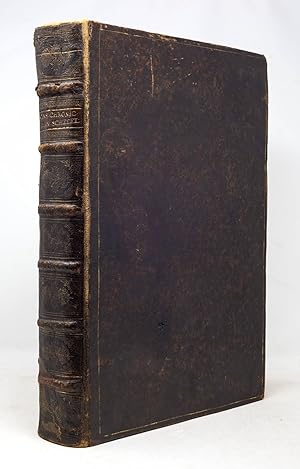
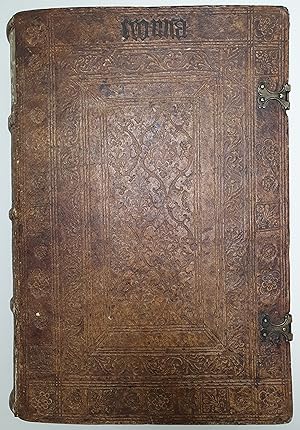


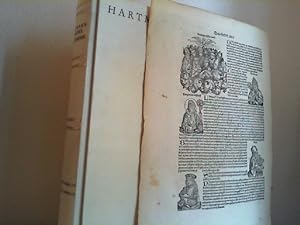
![Seller image for Herbipolis [1493]. [Altkolorierter Original-Holzschnitt]. for sale by Antiquariat Lenzen](https://pictures.abebooks.com/inventory/md/md30679244938.jpg)
